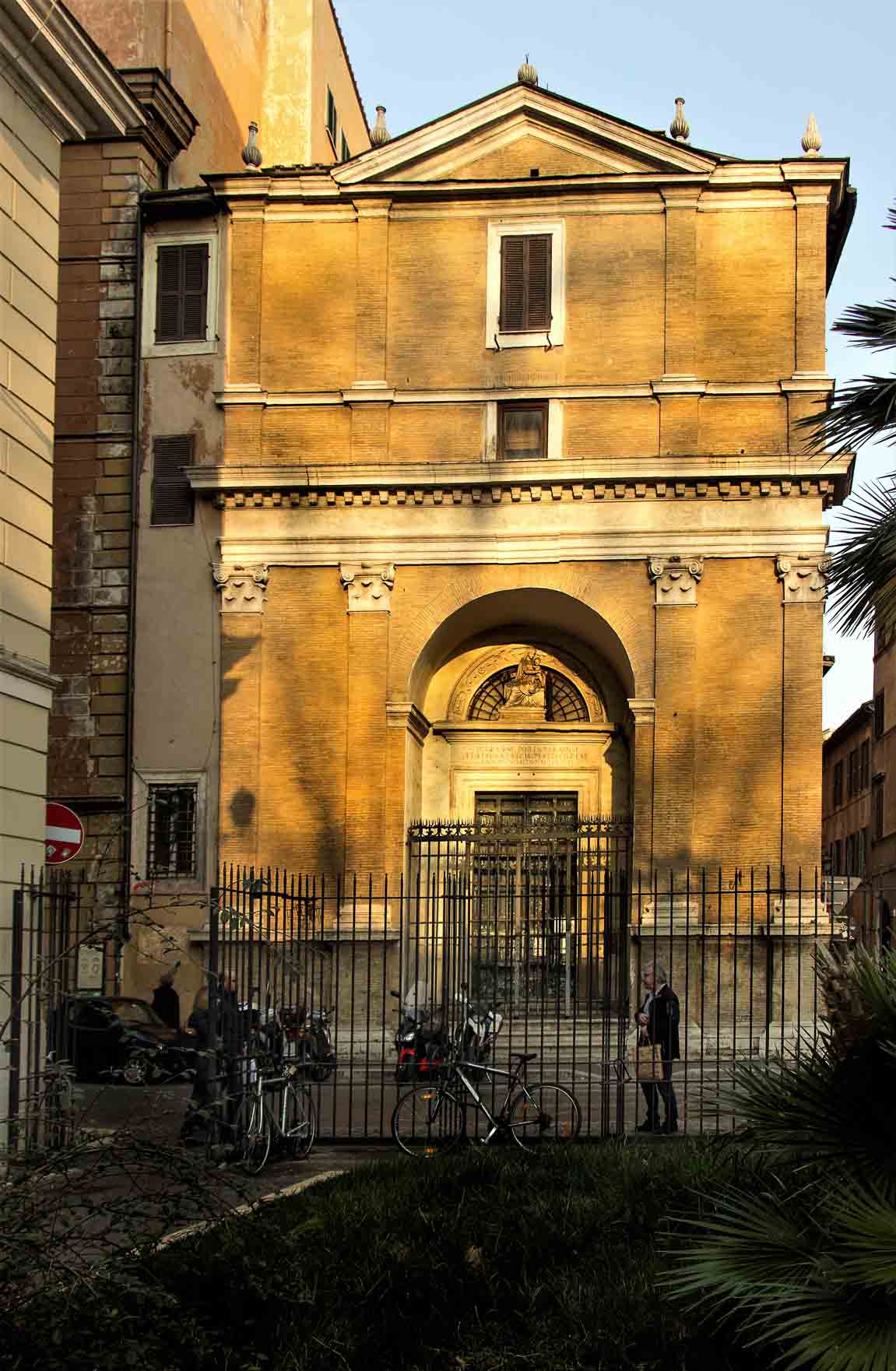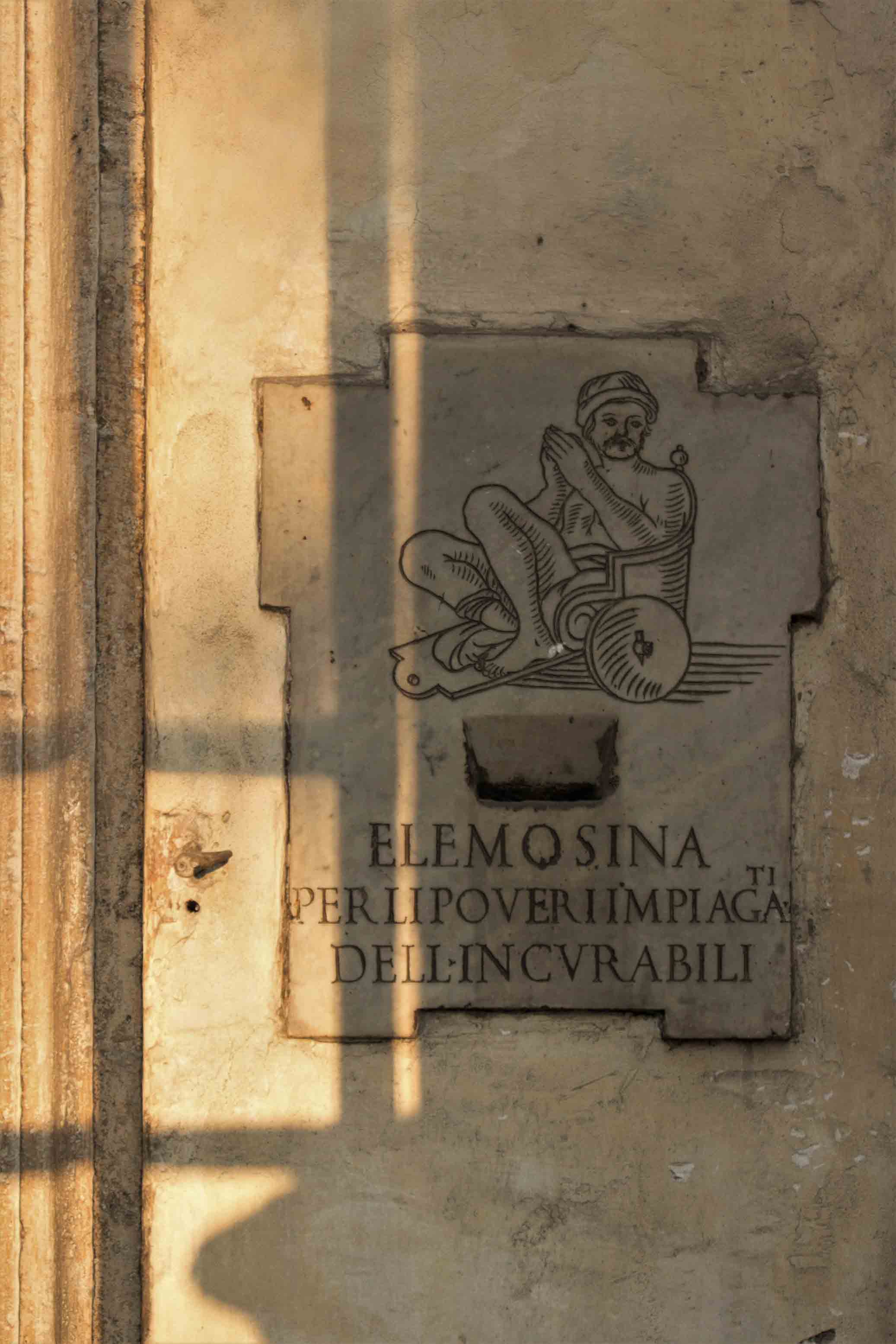
BUDOWLE & OBIEKTY Churches and chapels
Church of Santa Maria Portea Paradisi – a place reminiscent of a gate to paradise

The chapel which had existed here since the Middle Ages, acquired its present-day look in the XVI century after a reconstruction done by the famous Florentine architect, Antonio da Sangallo (the Younger). It was located at the communications artery set out by Pope Leo X (via Leonina – the latter via di Ripetta), leading pilgrims from the Ripetta port to the Piazza del Popolo, then to the Vatican. The remains of this period, are a simple, brick-made façade, which is adorned by four pilasters set on high plinths with composite capitols.
The enterance to the church leads through a semi-circular portico, whose tympanum contains a marble figure depicting Madonna with Child, attributed to the valued at that time sculptor – Andrea Sansovino. Underneath is an inscription: Eccl [Esia] S [anctae] M [ariae] Porta Paradisi et Liberatricis Pestilentiae, Anno Domini MDXXIII (Church of Holy Mary, the Gate of Paradise and Liberator from the plague, AD 1523”).
On the right side from the enterance there is an inconspicuous money box decorated with a relief. The simple drawing shows a praying man, seated in a wheelchair. This is a sort of a penultimate stage of earthly life – the ulcer-covered, generally unable to walk infirm, came here, brought by his family on a wheelbarrow, so that he could die in peace. The hospital was a kind of a hospice, from which generally there was no coming back. The inscription found below the drawing informs us, that donations are for those suffering from incurable diseases, while the represented man is praying for those who will aid the needy with their alms. This was a deed of mercy, which was highly recommended by the Church during the time of Lent or Advent, but here it was obligatory at all times.
The octagonal church interior was thoroughly modernized in the middle of the XVII century and today presents itself in a Baroque coat as a broad hall with repeating arcades, richly decorated with marble wall tapestries, pilasters, and interesting painting objects. It contains four door openings, of which three lead to the sacristy and other rooms designated for priests, while the fourth leads directly to the hospital. The whole is covered by an octagonal dome, whose fields are filled with paintings of Pietro Paolo Baldini – a known throughout Rome fresco artist, and a student of Pietro da Cortona. It is topped off with a lantern.

The main altar contains a convex marble relief by Francesco Brunetti, depicting angels and two saints – Joseph and a kneeling Anthony of Egypt. The figures direct their attention to the painting of the Madonna and Child set into the altar. It is part of a group of the so-called miraculous paintings, rather numerous in Rome (e.g. in San Giacomo in Augusta, Santa Maria dei Miracoli), which were treated with special reverence, during times of crises and various catastrophes, which the city experienced. Such a misfortune was the plague of 1523 (of which the inscription on the façade informs us), or four years later the barbarian invasion of Rome by the soldiers of Emperor Charles V, known as Sacco di Roma. Prayers directed to paintings and carrying them in processions with the aim of reversing fate, were a constant element of the then customs and spirituality.
The doors located on either side of the altar are adorned at their base with interesting funerary sculptures. One depicts a Spanish prelate, who died in 1523, Antonio de Burgos, the first benefactor of the church (donation of 1000 ducats in gold), the second, another – this time hospital doctor, who was buried in this location along with his wife (Mateo and Dorotea Cocci). These original tombstone solutions with a lying figure, which are a distant echo of the Sansovino concept, were created by Cosimo Fancelli – a student of Gian Lorenzo Bernini, mainly known for his figure of the angel from the Sudarium, completed for the Ponte Sant’Angelo (Bridge of the Holy Angel). The two side chapels are decorated with marble reliefs – one of them depicts Christ with a kneeling Mary Salome – the mother of his disciples and future apostles: James (Giacomo) and John the Evangelist (Cosimo Fancelli, 1645), the second Our Lady with St. Anne.
The church modernization in the spirit of the XVII century and its decoration with new sculptures and paintings was finalized in 1725. Its current interior is an example of typical for mature Baroque church, rich in stuccos, marble tapestries, wall paintings, and decorative altars.
This church served as an internal hospital chapel until the XIX century. In 1824 the Church of San Giacomo in Augusta, located opposite the hospital became a parish church, and thus the chapel grew in status to that of the principal hospital church.
Może zainteresuje Cię również
Cosimo Fancelli (1618–1688), a great, but second-tier master of the Roman Baroque
Zgodnie z art. 13 ust. 1 i ust. 2 rozporządzenia Parlamentu Europejskiego i Rady (UE) 2016/679 z 27 kwietnia 2016 r. w sprawie ochrony osób fizycznych w związku z przetwarzaniem danych osobowych i w sprawie swobodnego przepływu takich danych oraz uchylenia dyrektywy 95/46/WE (RODO), informujemy, że Administratorem Pani/Pana danych osobowych jest firma: Econ-sk GmbH, Billbrookdeich 103, 22113 Hamburg, Niemcy
Przetwarzanie Pani/Pana danych osobowych będzie się odbywać na podstawie art. 6 RODO i w celu marketingowym Administrator powołuje się na prawnie uzasadniony interes, którym jest zbieranie danych statystycznych i analizowanie ruchu na stronie internetowej. Podanie danych osobowych na stronie internetowej http://roma-nonpertutti.com/ jest dobrowolne.